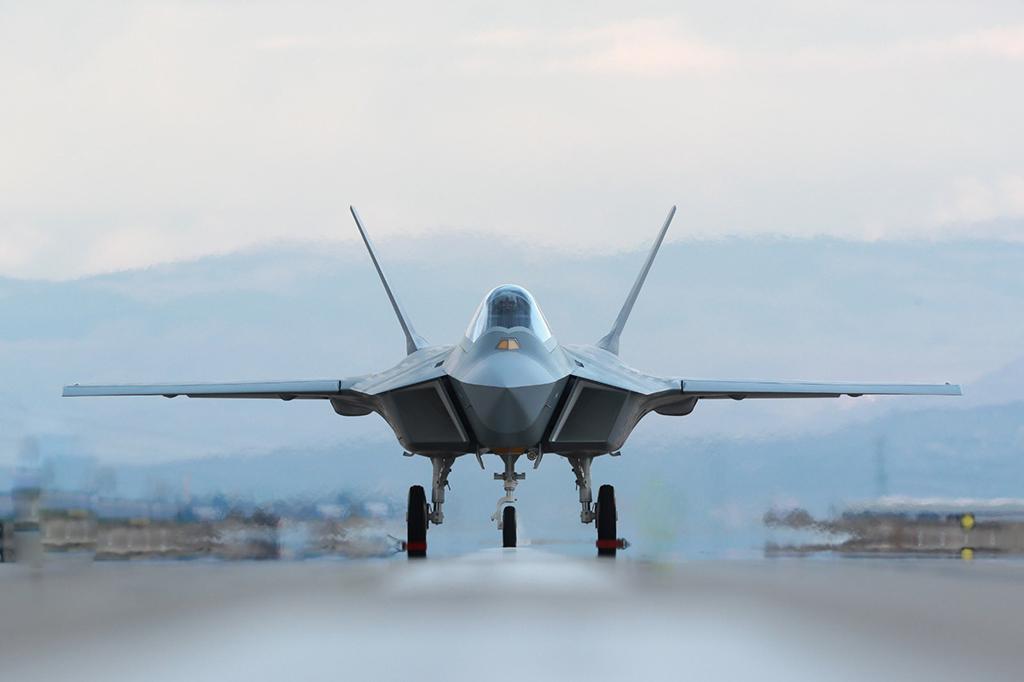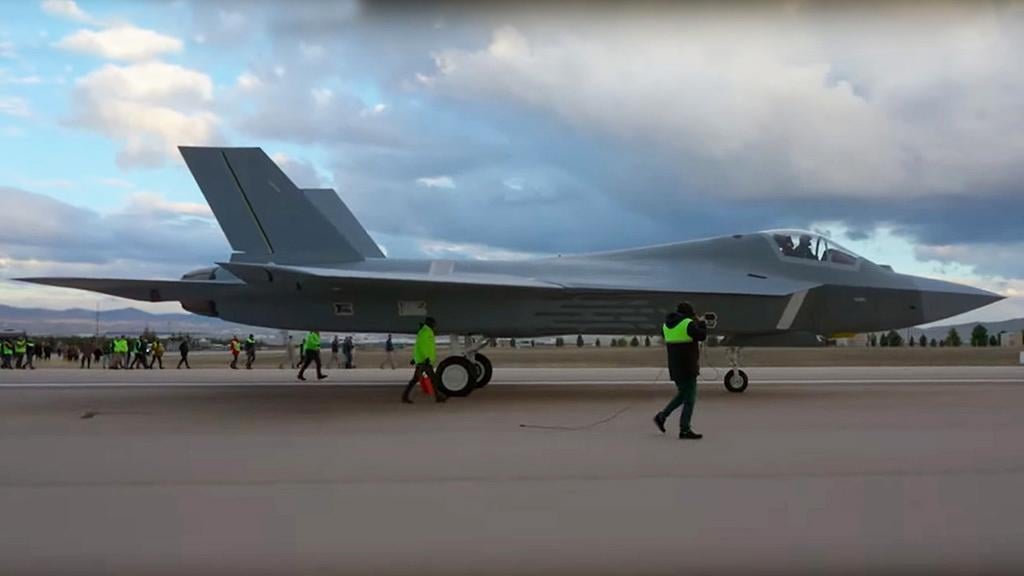
First-Flight Plans
More elements of the low-observability features can be seen in this second video still, with serrated edges around the engine exhausts and efforts to make access panels flush with the rest of the fuselage, although it is unclear what investments have been made in low-observable materials and coatings for the platform and how maintainable they will be once in operation. Officials have not said whether this first prototype is capable of flight, but Turkish Aerospace CEO Temel Kotil said in January that a first flight could take place by year-end. Before that statement, a first flight had been planned for March 2025. Officials are hoping to run the rollout ceremony in late April or early May, after Ramadan and before the May 14 presidential election.

Fifth-Generation Look
While the planned March 18 rollout of the TF-X, or MMU as it is known in Turkey, was postponed following the devastating earthquakes on Feb. 6, Turkish authorities have been publishing images of the first prototype using social media, revealing significant adjustments to the platform’s design compared to artists’ impressions and concepts published by manufacturer Turkish Aerospace Industries during the last six years.

Early Studies
Turkey has been studying the potential of developing its own combat aircraft since the early 2000s as an exportable complement to the Lockheed Martin F-35 Joint Strike Fighter, of which Turkey was a key industrial partner. In the early 2010s, Sweden’s Saab was drafted in as a consultant to the project and assisted on concepts for three aircraft configurations: two conventional monoplane layouts—one with a single engine, not dissimilar to the F-35—and another with two engines, while the third featured canard foreplanes and a large delta wing. The Turkish Air Force, the primary customer for the program, would ultimately opt for the twin-engine configuration, as it sought a platform that would ultimately replace most of the Lockheed Martin F-16s in service.

Firming Up Design
Until 2017, the TF-X program was the only new fighter being developed on that side of the Atlantic. European initiatives around future combat air systems (FCAS) had not yet kicked off and only the UK and France were exploring a joint uncrewed combat air vehicle. As a result, there was considerable international interest in Turkey’s project. Turkish Aerospace sought a partner to support initial design and development for the fighter, and after an initial tender, the UK’s BAE Systems secured a £123 million ($150 million) agreement to act as a foreign collaboration partner for the program. More than 100 BAE engineers were sent to Turkey to not only support the program, but also build up skills that could be used for the UK’s own FCAS efforts, which were formally launched in 2018.

Assembly Underway
The first components for the prototype TF-X began emerging at the end of 2021. The Turkish government had opted by then for an off-the-shelf engine—General Electric’s F110—to power the first prototypes and likely the first early production batches. Turkish Aerospace is familiar with the engine, which is license-built in Turkey for the country’s F-16 program. In this image taken late last year, the first prototype is pictured in an advanced state of assembly. Turkish Aerospace has also been developing an ecosystem of suppliers in-country to produce components for the aircraft, reducing the aircraft’s costs, and reliance on foreign suppliers and pushing to make it U.S. International Traffic in Arms Regulations-free. TF-X’s active, electronically scanned array radar is being developed by Aselsan, as are the aircraft’s avionics. Defense company Havelsan has been working on the training and maintenance software systems, as well as cyberdefenses for the platform.

Low-Observability Features
Given the requirements for low observability, it is hardly surprising that the TF-X looks like other combat aircraft platforms, including the Lockheed Martin F-22 and Korea Aerospace Industries KF-21, although the TF-X is likely to be closer in size and weight to the U.S. aircraft. In this image, taken from a video of what is believed to be the first outdoor engine runs, the all-moving horizontal stabilizer can be seen. The aircraft also sits higher off the ground, and appears to feature a broader and bulkier fuselage, which could possibly accommodate more fuel and allow deeper weapon bays, than earlier concept drawings suggested.

First-Flight Plans
More elements of the low-observability features can be seen in this second video still, with serrated edges around the engine exhausts and efforts to make access panels flush with the rest of the fuselage, although it is unclear what investments have been made in low-observable materials and coatings for the platform and how maintainable they will be once in operation. Officials have not said whether this first prototype is capable of flight, but Turkish Aerospace CEO Temel Kotil said in January that a first flight could take place by year-end. Before that statement, a first flight had been planned for March 2025. Officials are hoping to run the rollout ceremony in late April or early May, after Ramadan and before the May 14 presidential election.

Fifth-Generation Look
While the planned March 18 rollout of the TF-X, or MMU as it is known in Turkey, was postponed following the devastating earthquakes on Feb. 6, Turkish authorities have been publishing images of the first prototype using social media, revealing significant adjustments to the platform’s design compared to artists’ impressions and concepts published by manufacturer Turkish Aerospace Industries during the last six years.

Early Studies
Turkey has been studying the potential of developing its own combat aircraft since the early 2000s as an exportable complement to the Lockheed Martin F-35 Joint Strike Fighter, of which Turkey was a key industrial partner. In the early 2010s, Sweden’s Saab was drafted in as a consultant to the project and assisted on concepts for three aircraft configurations: two conventional monoplane layouts—one with a single engine, not dissimilar to the F-35—and another with two engines, while the third featured canard foreplanes and a large delta wing. The Turkish Air Force, the primary customer for the program, would ultimately opt for the twin-engine configuration, as it sought a platform that would ultimately replace most of the Lockheed Martin F-16s in service.

Firming Up Design
Until 2017, the TF-X program was the only new fighter being developed on that side of the Atlantic. European initiatives around future combat air systems (FCAS) had not yet kicked off and only the UK and France were exploring a joint uncrewed combat air vehicle. As a result, there was considerable international interest in Turkey’s project. Turkish Aerospace sought a partner to support initial design and development for the fighter, and after an initial tender, the UK’s BAE Systems secured a £123 million ($150 million) agreement to act as a foreign collaboration partner for the program. More than 100 BAE engineers were sent to Turkey to not only support the program, but also build up skills that could be used for the UK’s own FCAS efforts, which were formally launched in 2018.

Assembly Underway
The first components for the prototype TF-X began emerging at the end of 2021. The Turkish government had opted by then for an off-the-shelf engine—General Electric’s F110—to power the first prototypes and likely the first early production batches. Turkish Aerospace is familiar with the engine, which is license-built in Turkey for the country’s F-16 program. In this image taken late last year, the first prototype is pictured in an advanced state of assembly. Turkish Aerospace has also been developing an ecosystem of suppliers in-country to produce components for the aircraft, reducing the aircraft’s costs, and reliance on foreign suppliers and pushing to make it U.S. International Traffic in Arms Regulations-free. TF-X’s active, electronically scanned array radar is being developed by Aselsan, as are the aircraft’s avionics. Defense company Havelsan has been working on the training and maintenance software systems, as well as cyberdefenses for the platform.

Low-Observability Features
Given the requirements for low observability, it is hardly surprising that the TF-X looks like other combat aircraft platforms, including the Lockheed Martin F-22 and Korea Aerospace Industries KF-21, although the TF-X is likely to be closer in size and weight to the U.S. aircraft. In this image, taken from a video of what is believed to be the first outdoor engine runs, the all-moving horizontal stabilizer can be seen. The aircraft also sits higher off the ground, and appears to feature a broader and bulkier fuselage, which could possibly accommodate more fuel and allow deeper weapon bays, than earlier concept drawings suggested.

First-Flight Plans
More elements of the low-observability features can be seen in this second video still, with serrated edges around the engine exhausts and efforts to make access panels flush with the rest of the fuselage, although it is unclear what investments have been made in low-observable materials and coatings for the platform and how maintainable they will be once in operation. Officials have not said whether this first prototype is capable of flight, but Turkish Aerospace CEO Temel Kotil said in January that a first flight could take place by year-end. Before that statement, a first flight had been planned for March 2025. Officials are hoping to run the rollout ceremony in late April or early May, after Ramadan and before the May 14 presidential election.
Turkey’s TF-X combat aircraft is the jewel in the crown of Turkey’s vision of becoming one of the world’s top defense exporters, but what is the story behind the country’s indigenous fighter development and what can be gleaned from the images released by Ankara during initial testing?






